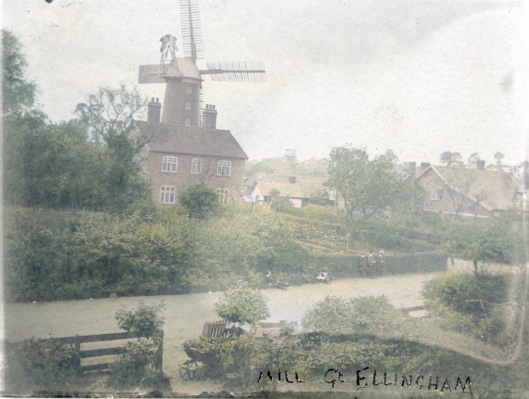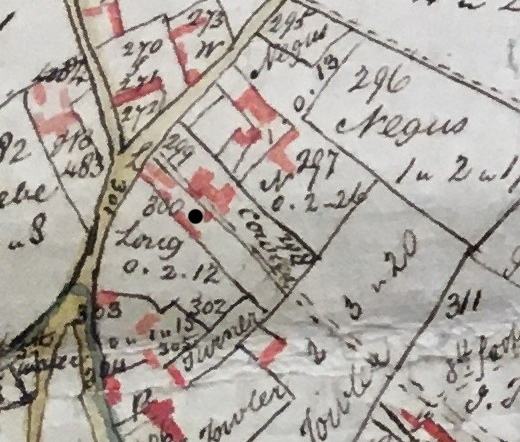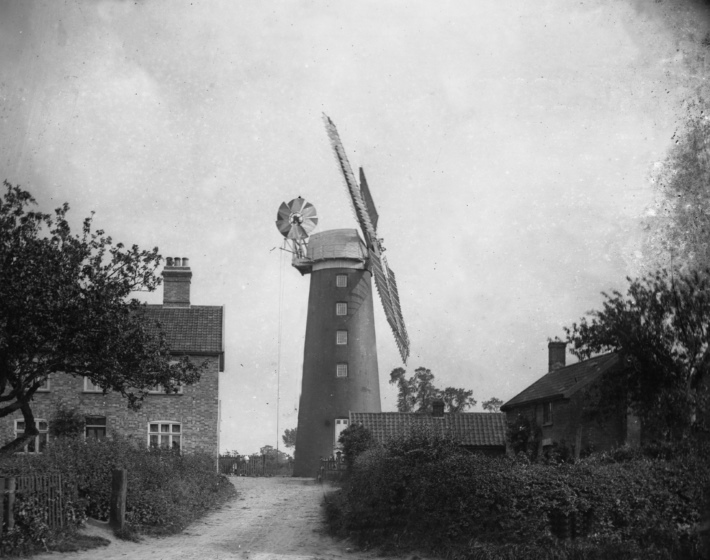Mill House which replaced an earlier dwelling with the Mill behind. Postcard postmarked 1905.
Tower Windmill made from Local Bricks
The brick tower windmill standing in what is now Church Street, Great Ellingham, was erected by Jeremiah Fielding c.1849. The bricks were made locally at the brick kiln in Hingham Road. It has also been said that the tower mill was built without the use of any scaffolding!
The village already had a working post-mill in Mill Lane. There had also been a much earlier mill off Penhill Road.
Where was the Mill?
Extract from 1802 Map of Great Ellingham. Original held at Norfolk Record Office. Russell James Colman Plans. Cat. Ref. C/Ca 1/84. With kind permission of NRO
The black dot on the above extract from an 1802 map shows the approximate position of the tower windmill. Although the map pre-dates the building of the windmill by some 40 years, it shows the position of other nearby buildings which may well have still been in situ when mill was built.
1849
Sale by Auction on 2nd April
Notice of the sale by auction of premises in Great Ellingham, which included “a newly erected tower windmill“, dwelling house and baker’s shop, appeared in the Bury & Norwich Post of 28th March, 1849. The auction would take place at the nearby Crown Inn on the 2nd April.
The mill with sails and sail cloths, comprising five floors, had a working pair of stones. James Buck occupied the mill.
Also being sold were three cottages (adjoining each other) as well as a nearby small barn. The extract from the 1802 map also shows the position of these cottages within the piece of land number 300 (containing the black dot). James Buck, Frances Buck and Sophia When occupied these cottages.
The dwelling house and the baker’s shop “wherein a good trade was carried out for many years“, together with a garden, orchard and a piece of land was also part of the premises being sold. This thatched-roofed dwelling house (with the baker’s shop) is within the parcels of land numbered 299 and 298 on the 1802 map.
In 1904, a fire partly destroyed the house and baker’s shop. In consequence, it was replaced by the present Mill House.
For Sale or Let
We can only assume that the premises and land (including the mill) did not sell at the auction on the 2nd April, 1849. Perhaps the seller withdrew the premises from the sale, or, maybe, there were no interested parties. It is, of course, also possible that the bidding did not reach any reserve price.
In any event, around five months later, the Norfolk News of the 15th September, 1849, printed a further notice for the sale or let of the windmill, messuage, baker’s shop, cottages etc.
The freehold properties were situated in Great Ellingham “near the Street in a populace neighbourhood, being eligible for the Trades of a Miller and Baker“.
In an attempt to gain interest, the seller offered to let the property to a tenant at a low rent. A buyer had the option of leaving a considerable part of the purchase price owing on a mortgage “at a moderate rate of interest“.
The cottages were still occupied by tenants.
1849 Ownership
I am unclear as to whether Jeremiah Fielding owned the mill and the associated properties at this time. His name is not mentioned in either of the notices. However, he did erect the mill around this time, and it would seem feasible that he would have had at least an equitable interest in the properties, even if he did not actually own them.
1854 Private Sale
On the 16th September, 1854, a notice directed to ‘Millers & Bakers’ appeared in the Norwich Mercury.
A new brick tower-mill with dwellinghouse, bake office, stable, outbuildings, three cottages and one acre of land was once again offered for sale. This time the seller was looking to sell by way of a private contract (as opposed to auction).
Interested parties were to apply to ‘J Fielding on the premises’. This suggests that Jeremiah Fielding was occupying the house and mill in 1854.
1851 census
Three years earlier, the 1851 census captures 28 year old miller Jeremiah Fielding with his 29 year old wife, Mary Ann, and one year old son, John Joseph, living in Mill Lane, Great Ellingham. Jeremiah had an apprentice, 15 year old Robert Duffield born in Old Buckenham. Mary Ann’s sister, Elizabeth Harvey, is also with the Fielding household.
Given that the census specifically states that the Fielding family were in Mill Lane, we know they were not at this time living in the dwelling house at the ‘newly erected’ tower mill in the Street.
Jeremiah Fielding – Miller & Baker
Earlier, Hunt’s Directory of 1850 mentions Jeremiah Fielding as a miller in Great Ellingham. However, White’s Directory of 1854 shows Jeremiah Fielding as a baker in Great Ellingham.
Accordingly, it is likely that by 1854 (when the notice of a private sale appeared in the Norwich Mercury), the Fielding family had indeed moved from the mill in Mill Lane to the dwelling house with baker’s shop and tower mill in the Street.
Who was Jeremiah Fielding?
Jeremiah was born on the 16th February, 1823. George IV had been on the throne for three years. It would be another 14 years before the young Queen Victoria acceded to the throne following the death of her uncle, King William IV.
Rockland St Peter Church
Baptism
A son of first cousins John and Esther Fielding, Jeremiah was baptised in the Parish Church in Rockland St Peter on the 23rd February, 1823. He was one of at least seven children.
Jeremiah spent his early life in Rocklands. The 1841 census finds Jeremiah with his parents in Rockland St Peter.
Marriage
At the age of 23, Jeremiah married 22 year old dressmaker, Mary Ann Harvey, at the Parish Church of East Harling on May 3rd, 1846. Jeremiah was then working as a miller. Both Mary Ann and Jeremiah were living in East Harling.
Sons
The couple had four sons between 1846 and 1854. James was born in Rocklands on the 3rd October, 1846 followed by John Joseph in 1850. William Alfred was born in Great Ellingham at the end of 1852. Sadly, Jeremiah and Mary Ann buried William just three weeks later in the churchyard of St James on January 16th, 1853. Mary Ann gave birth to another son the following year, whom they also named William Alfred.
Thoughts of Emigration
It may have been during the time that the Fielding family were living in Great Ellingham, that Jeremiah began to have thoughts about emigrating.
It is believed that Jeremiah was recruited (with other local people) by missionaries of the Launceston Immigration Aid Society to emigrate to Tasmania.
As a god-fearing and upstanding member of the community, Jeremiah’s purpose would be set up businesses that would provide employment for the many convicts that had been transported from Britain to Van Diemen’s Land (known as Tasmania from 1856). Once a convict had served his or her sentence, there was little chance of ever getting back to Britain!
Jeremiah may also have seen emigration as a new challenge with good prospects and opportunities for him and his family.
Death of Father, John Fielding & Legacy
Jeremiah’s father, John Fielding, died in Great Ellingham in 1850.
John Fielding owned several properties. His will specifically mentions his messuage (double tenement) and two acres of land in Little Ellingham. John left this property to his wife Esther, but only for her lifetime. On Esther’s death, Jeremiah’s sister, Ann (and subsequently her son, William) would inherit this property.
John Fielding directed his executors to sell all his other messuages and lands. After the payment of all his debts and funeral expenses, two legacies and a sum to be invested to provide an income for Esther, the proceeds from the sales of the properties were to be equally divided among Jeremiah and his sisters, Elizabeth and Susanna.
Accordingly, Jeremiah received a legacy from his father’s estate which, with the proceeds of the sale of the windmill and the associated premises, would go some way to fund his family’s emigration to Tasmania.
1854 Sale to Samuel Le Grice
Tower Mill, Great Ellingham. After 1905. Photograph Attleborough Heritage Group
On the 12th October, 1854, Jeremiah Fielding conveyed the following premises to Samuel Le Grice, a grocer & draper of Banham, for the price of £825:
- the dwelling house (messuage) in Great Ellingham with baking office, barns, stables, outbuilding, yards and gardens
- three cottages in Great Ellingham with outbuildings and yards
- piece of land adjoining the cottages and messuage comprising 0a 3r 28p
- brick tower windmill (lately erected by Jeremiah Fielding) together with the machinery, going gears and fixtures
Former occupiers of these premises were Jeremiah Fielding, Stephen Houchen, ____ When and Jane Barnard.
However, the premises were now occupied by Jeremiah Fielding, Sophia When and Esther Fielding (Jeremiah’s mother).
The sale to Samuel Le Grice also included all Jeremiah Fielding’s other messuages, cottages, lands and tenements in Great Ellingham. I do not know any further details of these properties.
Five days before the completion of the sale to Samuel Le Grice, Jeremiah Fielding was a party to an Indenture of Release dated 7th October, 1854.
Trust Release
The Deed was made between (1) John Everett, a gentleman (2) William Everett, a warehouseman (3) Richard Bowles Atmore, a gentleman (4) Jeremiah Fielding and (5) William Lebbell, carpenter.
In a nutshell, the Deed confirmed the release of property and lands (i.e. the premises and lands which Jeremiah Fielding subsequently sold to Samuel Le Grice) which had been held in trust for the use of Jeremiah Fielding (and for the use of William Lebbell during Jeremiah Fielding’s lifetime). These premises and land were released to Jeremiah Fielding free from the trust.
Great Ellingham to Tasmania
Not long after the sale of the premises (including the tower windmill) to Samuel Le Grice in October, 1854, Jeremiah Fielding with his wife and three young sons left Great Ellingham for a new life in Australia.
The family boarded the SS Whirlwind bound for Tasmania. Were the family aware that their journey was likely to be long and perilous?
Death of William Alfred at Sea
Having safely travelled well over 7,000 miles, the family was struck by tragedy. On the 9th January, 1855, whilst at sea at Sulawesi, Tengah, Indonesia, Jeremiah and Mary Ann’s infant son, William Alfred, died. The child may well have caught a sickness associated with abysmal living conditions and poor hygiene.
Map of Tasmania taken from page 104 of The Life of a Century (1901) by Edwin Hodder
Arrival in Launceston, Tasmania
On the last day of March, 1855, Jeremiah and Mary Ann with their two remaining sons (James and John), arrived at Launceston, Tasmania. They must have been very relieved to finally reach their destination.
Further Children
Sadly, just over two months later, John Joseph (who was then around the age of 5) died in Launceston.
There was brighter news for the Fielding family in 1857, when their son John Allen Fielding was born on the 7th June in Deloraine.
However, life would once again be cruel to the family when, barely two months old, John Allen died on the 19th August.
Jeremiah and Mary Ann welcomed another son, Charles William, in 1859 whilst they were living in Westbury.
Death of Mary Ann Fielding
Aged just 39, Mary Ann Fielding (neé Harvey) died in Exton, Tasmania on the 11th July, 1863.
In the same month, but over 10,000 miles away, Jeremiah’s mother, Esther, also died. Esther was buried in the churchyard at Rockland St Peter on the 18th July, 1863. It would have been many weeks (if not months) before Jeremiah would learn of his mother’s death.
Marriage to Lucy Maria Illenden
Eighteen months later, Jeremiah married Lucy Maria Illenden in Westbury, Tasmania on the 19th January, 1865. Jeremiah was then 42 and his new bride around the age of 28.
Children
Frederick Percy John Fielding was born on the 5th February, 1866 at Westbury. Frederick was followed a year later by Ernest Joseph in 1867 and Frank Charlton on the 18th December, 1868. Sadly, Jeremiah would suffer the loss of another son, when Frank died on the 21st February, 1869 at just two months old.
Jeremiah’s first daughter, Sophia May, was born at Westbury in 1870 with Louisa Illenden two years later on the 26th May, 1872. Another daughter, Lucy Anne, arrived on the 23rd June, 1874.
Lucy was followed by George Percy on the 14th August, 1876 in Westbury, with Francis Robert Edward Fielding making an appearance in 1879 when the family had moved back to Deloraine. Sadly, baby Francis died on the 3rd March, 1880.
Jeremiah and Lucy had two more children – daughter Hester Marion Hanna Fielding arrived on the 15th January, 1881 followed by Jeremiah and Lucy’s last child, a son named Ira Harold, born in 1884 in Ulverstone.
Jeremiah Fielding had then reached the age of 60. Sadly, he did not live to see Ira celebrate his first birthday.
Death of Jeremiah Fielding
It is believed that the Fielding family had water-powered flour and saw mills in Tasmania.
Jeremiah Fielding, a Rocklands born man, who was responsible for the erection of the brick tower mill in Great Ellingham died in Penguin, Tasmania on the 18th September, 1884.
After some 170 years, the brick windmill (albeit without the cap and sails) still stands in the village today. A great legacy to Jeremiah Fielding.
Sources:
‘A Little History of Great Ellingham’. Lebbell W R & Fay S. c.1965
Bury & Norwich Post 28th March, 1849 viewed via www.britishnewspaperachive.co.uk 13th March, 2021
Norfolk News 15th September, 1849 viewed via www.britishnewspaperachive.co.uk 13th March, 2021
Norwich Mercury (supplement) 16th September, 1854 viewed via www.britishnewspaperachive.co.uk 13th March, 2021
1851 census HO107/1823/141
1841 census HO107/785/22
Rockland St Peter Parish Registers. Norfolk Record Office. PD336.Transcription, Baptisms & Burials. Norfolk Family History Society www.norfolkfhs.org.uk
Great Ellingham Parish Registers. Norfolk Record Office.PD 609. East Harling Parish Registers. Norfolk Record Office. PD219. Also available at www.familysearch.org
Hunt’s Directory 1850. Viewed via https:www.genuki.org.uk/big/eng/NFK/Ellingham_Great/Hunt1850 accessed 14th January, 2019
White’s Directory 1854. Viewed via https://apling.freeservers.com/Villages/EllinghamGreat54.htm accessed 14th January, 2019
1850 Fielding, John, of Great Ellingham. Norfolk Record Office. ANF will register 1848-1850 fo.491 (1850 no.50) Viewed via Norfolk Sources website http://www.norfolksources.norfolk.gov.uk/DserveNS/ 17th March 2021
Great Ellingham Tower Mill. 1854-1906. Transcripts of appointment and release between Jeremiah Fielding of Great Ellingham, Miller and Samuel Le Grice of Banham, Grocer & Draper of a freehold estate in Great Ellingham (12 October 1854), conveyance of freehold land in Great Ellingham from Samuel Le Grice to Samuel Le Grice (junior) in 1904 and abstract of the trustee of sale under the will of Samuel Le Grice (1906). Harry Apling; 1904-1990; historian, author; Essex, Hingham, Norfolk (1904-1990). Norfolk Record Office. Catalogue Ref: C/WT/1/19/50
State Library New South Wales website accessed 19th March 2021. 17 Jan 1942 The Advocate https://trove.nla.gov.au/newspaper/article/68750175 accessed 22 March 2021
Thanks to Bryan Dye for the Fielding family information




